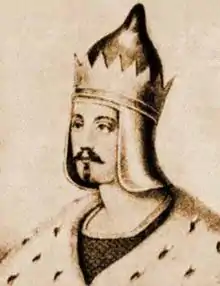Iziaslav I of Kiev
Iziaslav Yaroslavich (Old East Slavic: Изѧславь Ѩрославичь; Russian: Изяслав Ярославич; Ukrainian: Ізяслав Ярославич; 1024 – 3 October 1078, baptized as Demetrius) was a Kniaz' (Prince) of Turov and Grand Prince of Kiev from 1054.
| Iziaslav I | |||||
|---|---|---|---|---|---|
| Grand Prince of Kiev | |||||
 | |||||
| Reign | 1054–1068, 1069–1073, and 1076–1078 | ||||
| Predecessor | Yaroslav the Wise | ||||
| Successor | Sviatoslav II | ||||
| Prince of Turov | |||||
| Reign | 1045–1052 | ||||
| Prince of Novgorod | |||||
| Reign | 1052–1054 | ||||
| Born | 5 February 1024 | ||||
| Died | 3 October 1078 (aged 54) Nezhatyna Nyva | ||||
| Burial | |||||
| Spouse | Gertrude of Poland, Casimir's sister | ||||
| Issue | Yaropolk Izyaslavich, Mstislav, Sviatopolk II | ||||
| |||||
| Dynasty | Volodimerovichi | ||||
| Father | Yaroslav the Wise | ||||
| Mother | Ingegerd Olofsdotter (a daughter of Olof Skötkonung) | ||||
| Seal |  | ||||
Iziaslav's children Yaropolk and Sviatopolk would rule the Turov Principality. Their authority was mainly challenged by the Rostilavichi of Rostislav Vsevolodovich.
Biography
Iziaslav was the oldest son of Yaroslav I the Wise by his second wife Ingigerd Olafsdottir. Iziaslav succeeded his father, after Yaroslav's oldest child, Vladimir (the only child by Yaroslav's first wife), had predeceased his father. Iziaslav was one of the authors of "Pravda Yaroslavichiv" – a part of the first legal code of Rus, called Russkaya Pravda.
He is also credited with the foundation of the Kiev Pechersk Monastery. Prince Iziaslav I of Kiev ceded the whole mountain to Antonite monks who founded a monastery built by architects from Constantinople. According to the Primary Chronicle, in the early 11th century, Antony, a Greek Orthodox monk from Esphigmenon monastery on Mount Athos, originally from Liubech in the Principality of Chernigov, returned to Rus' and settled in Kiev as a missionary of the monastic tradition to Kievan Rus'. He chose a cave at the Berestov Mount that overlooked the Dnieper River and a community of disciples soon grew.
In 1043 his father Veliki Kniaz (Grand Prince) Yaroslav made an agreement with King Casimir I of Poland that recognized Cherven as part of Kiev. The agreement was sealed with a double marriage: Casimir to Dobronega, Yaroslav's sister; and Iziaslav to Gertrude, Casimir's sister.[1] From this marriage were born three children: Iziaslav's son Yaropolk, Mstislav and Sviatopolk. Upon the death of Yaroslav the Wise, his realm was divided between three of his older sons (Vladimir of Novgorod died before that), Izyaslav, Sviatoslav, and Vsevolod, creating the Yaroslavichi triumvirate that ruled the country for the next 20 years.
As a result of the popular uprising in 1068, Iziaslav was deposed and fled to Poland.[1] In 1069 he retook Kiev with the help of the Polish army; however, he was ousted again by his brothers in 1073. Iziaslav turned to the German king Henry IV, Holy Roman Emperor, Polish king Bolesław II the Bold, and Pope Gregory VII, for help on several occasions. Iziaslav became the first King of Rus' in 1075 when the Pope sent him a crown. He succeeded in retaking Kiev once again in 1076, but soon died in an internecine war against Princes Oleg Sviatoslavich and Boris Vyacheslavich.
Children
Iziaslav had the following children with Gertrude:
- Yaropolk
- Mstislav (?–1069), was a Prince of Novgorod (1054–1067) which he lost to Vseslav of Polotsk. He had a son Rostislav Mstislavich that died in 1093.
- Eupraxia, may have been married to Mieszko Bolesławowic, son of Bolesław II the Bold in 1088.
- Sviatopolk ΙΙ grand prince of Kiev.
Ancestry
| Ancestors of Iziaslav I of Kiev | |||||||||||||||||||||||||||||||||||||||||||||||||||||||||||||||||||||||||||||||||||||||||||||||||||||||||||||||||||||||||||||||||||||||||||||||||||||||||||||||||||||||||||||||||||||||||||||||||||||||||||||||||||||||||||||||||||||||||||||||||||||||||||||||||||||||||
|---|---|---|---|---|---|---|---|---|---|---|---|---|---|---|---|---|---|---|---|---|---|---|---|---|---|---|---|---|---|---|---|---|---|---|---|---|---|---|---|---|---|---|---|---|---|---|---|---|---|---|---|---|---|---|---|---|---|---|---|---|---|---|---|---|---|---|---|---|---|---|---|---|---|---|---|---|---|---|---|---|---|---|---|---|---|---|---|---|---|---|---|---|---|---|---|---|---|---|---|---|---|---|---|---|---|---|---|---|---|---|---|---|---|---|---|---|---|---|---|---|---|---|---|---|---|---|---|---|---|---|---|---|---|---|---|---|---|---|---|---|---|---|---|---|---|---|---|---|---|---|---|---|---|---|---|---|---|---|---|---|---|---|---|---|---|---|---|---|---|---|---|---|---|---|---|---|---|---|---|---|---|---|---|---|---|---|---|---|---|---|---|---|---|---|---|---|---|---|---|---|---|---|---|---|---|---|---|---|---|---|---|---|---|---|---|---|---|---|---|---|---|---|---|---|---|---|---|---|---|---|---|---|---|---|---|---|---|---|---|---|---|---|---|---|---|---|---|---|---|---|---|---|---|---|---|---|---|---|---|---|---|---|---|---|---|
| |||||||||||||||||||||||||||||||||||||||||||||||||||||||||||||||||||||||||||||||||||||||||||||||||||||||||||||||||||||||||||||||||||||||||||||||||||||||||||||||||||||||||||||||||||||||||||||||||||||||||||||||||||||||||||||||||||||||||||||||||||||||||||||||||||||||||
References
- Simon Franklin, Jonathan Shepard, The Emergence of Rus 750–1200, (Routledge, 2013), 253.
- Harvard Ukrainian studies, Vol. 12–13, p. 190, Harvard Ukrainian studies, 1990
- Yaroslav the Wise in Norse Tradition, Samuel Hazzard Cross, Speculum, 181-182.
- Arrignon J. —P. Les relations diplomatiques entre Bizance et la Russie de 860 à 1043 // Revue des études slaves. - 1983 .-- T. 55 . - S. 133-135 .
- Samuel Hazzard Cross (April 1929). "Yaroslav the Wise in Norse Tradition". Speculum. 4: 181.
- Winroth, Anders (2016). The age of the Vikings. Princeton. p. 50. ISBN 978-0-691-16929-3. OCLC 919479468.
Sources
- Martin, Janet. Medieval Russia, 980–1584 (Cambridge Medieval Textbooks)
External links
- Holy Dormition Kiev-Pechersk Lavra – Official site (in Russian)
- Genealogy of Yaroslav descendants (in Ukrainian)
- Izyaslav Yaroslavich at hrono.info